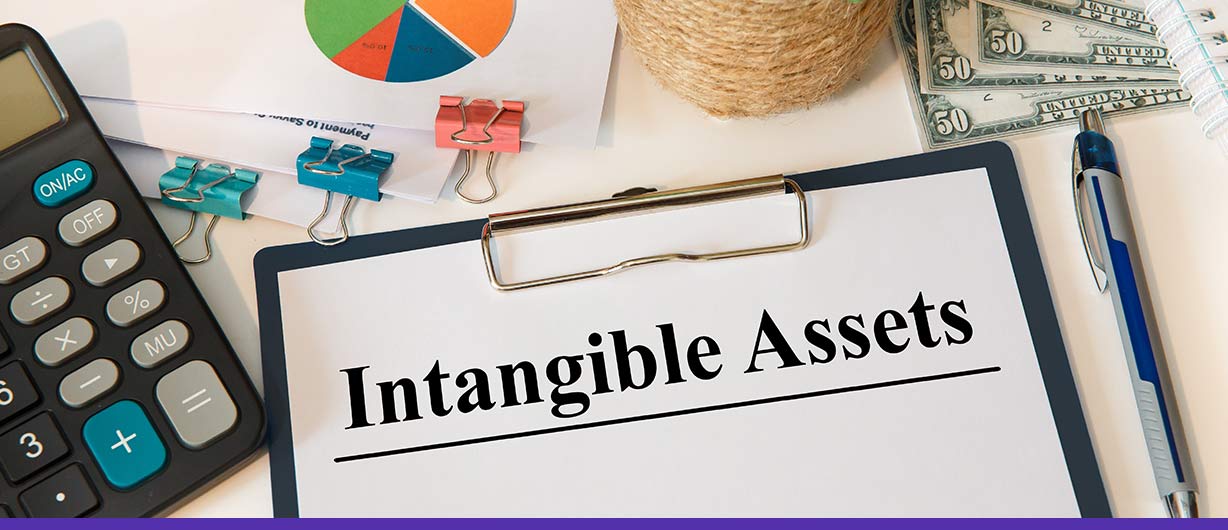April 13 2023 | By Farwah Jafri | 6 minutes Read

Purpose of Intangible Assets in Businesses
Brand Recognition
Competitive Advantage
Revenue Generation
Financing
Mergers and Acquisitions
Tangible Assets vs Intangible Assets
Tangible assets in accounting
Intangible assets in accounting
Step-by-step Explanation in intangible Assets with Example
1. Acquisition cost
2. Accumulated amortization
3. Impairment losses
Types of Intangible Assets in Accounting
In a Nutshell
If you’re a small business owner, you might have heard of “intangible assets” but may not fully understand what it means.
Intangible assets refer to non-physical assets that have value to a business, such as intellectual property (patents, trademarks, copyrights), brand recognition, customer lists, and proprietary software. Unlike tangible assets, which can be seen and touched, intangible assets are often intangible and difficult to quantify.
Intangible assets can be critical to a company’s success, providing a competitive advantage and generating revenue. However, they can also be easily overlooked and undervalued, leading to potential missed opportunities.
In this blog, we’ll delve deeper into intangible assets and why they are essential for small businesses. We’ll also discuss how to identify, value, and protect intangible assets and provide tips for small business owners to leverage their intangible assets for growth and success.
Intangible assets lack physical substance but have value to a business. They are an important component of a company’s overall value and can be used for various purposes, including:
Intangible assets such as trademarks, patents, and copyrights protect a company’s brand, products, and services. These assets help to establish brand recognition, which is critical to a company’s success.
Intangible assets can give a company a competitive advantage. For example, proprietary technology or unique business processes can give a company an edge.
Some intangible assets, such as intellectual property, can be licensed or sold for a profit. This can provide a significant source of revenue for a company.
Intangible assets can be used as collateral for loans or as a basis for financing. Lenders may be more willing to provide financing if a company has valuable intangible assets that can be used as collateral.
Intangible assets can be a significant factor in mergers and acquisitions. A company with valuable intangible assets may attract potential buyers or merger partners more.
Overall, intangible assets are essential to a company’s success and can provide significant value in various ways.
Tangible assets are physical assets that have a physical form and can be touched or seen, such as buildings, machinery, equipment, vehicles, inventory, and land. These assets can be fixed or current and have a monetary value that can be depreciated over time.
On the other hand, intangible assets are assets that do not have a physical form, and their value is based on the rights or privileges they provide. Examples of intangible assets are; patents, trademarks, copyrights, goodwill, brand recognition, and customer lists.
The main dissimilarity between tangible and intangible assets is that tangible assets are physical and can be touched or seen. In contrast, intangible assets are non-physical and cannot be touched or seen. Tangible assets are typically depreciated over their useful lives, while intangible assets are usually amortized.
Following are the examples of tangible and intangible assets:
– A company’s manufacturing equipment
– A fleet of delivery trucks
– A warehouse or distribution center
– Land and buildings
– Raw materials and inventory
– A company’s trademark or brand name
– Patents for a new product or invention
– Copyrights on a book or movie
– A company’s customer lists or database
– Goodwill represents the value of a company’s reputation and relationships with customers and suppliers.
Intangible assets are non-physical assets that do not have a physical presence but provide long-term economic benefits to a company. Examples include patents, trademarks, copyrights, brand names, goodwill, and customer lists.
To calculate intangible assets in accounting, you can use the following formula:
Intangible assets = Acquisition cost – Accumulated amortization – Impairment losses
Here is a step-by-step explanation of each component of the formula with an example:
It is the amount of money that a company pays to acquire an intangible asset. For example, let’s say that a company paid $50,000 to acquire a patent.
Intangible assets are typically amortized over their useful life. This means that their cost is spread out over several years. To calculate the accumulated amortization, you need to know the intangible asset’s useful life and the amortization method. For example, let’s say that the patent’s useful life is ten years, and the company is using the straight-line amortization method. In this case, the accumulated amortization for the first year would be:
Accumulated amortization = (Acquisition cost / Useful life) x Number of years used Accumulated amortization = ($50,000 / 10) x 1 Accumulated amortization = $5,000
If the value of intangible assets declines, the company may need to record an impairment loss. For example, if the patent becomes obsolete, the company may need to write down the value of the patent.
Once you have calculated each of these components, you can use the formula to calculate the value of the intangible asset:
Intangible assets = $50,000 – $5,000 – $0 Intangible assets = $45,000
In this example, the value of the intangible asset is $45,000.
Intangible assets are non-physical assets but are valuable to a business. There are several types of intangible assets, including:
– Brand equity: The value of a brand’s reputation, recognition, and consumer loyalty.
– Patents: Exclusive rights granted to an inventor for a certain period to prevent others from using or selling their invention.
– Copyrights: Exclusive rights granted to authors, artists, and other creators for their original works.
– Trademarks: Symbols, logos, or words that distinguish a company’s products or services from its competitors.
– Goodwill: The intangible value of a company’s reputation, customer relationships, and other factors contributing to its success.
These intangible assets can be valuable to a business and contribute significantly to its overall value.
In conclusion, intangible assets are a crucial component of modern business accounting. Although they lack physical substance, they can significantly impact a company’s financial success. It is essential for companies to properly identify, measure, and report their intangible assets to ensure accurate financial reporting and valuation. By doing so, companies can effectively manage and leverage their intangible assets to enhance their competitive advantage and overall performance. Examples of intangible assets include trademarks, patents, copyrights, and customer relationships. Understanding the concept of intangible assets is vital for businesses and investors to make sensible decisions and achieve long-term success.
Also Read: A Guide To Unlock The Secrets Of Liabilities In Accounting
Subscribe for business tips, tax updates, financial fundamentals and more.
MORE BLOGS

If you’re a small business, we will absolutely get it if you say you’re having a hard time choosing a payment platform for your company. And […]
Learn More →
When it comes to accounting, businesses often face a confusing question: which accounting method should we adopt? The choice typically boils down to the cash basis […]
Learn More →
Driving for Uber or delivering with Uber Eats can be a flexible and rewarding way to earn money. But when tax season rolls around, many drivers […]
Learn More →